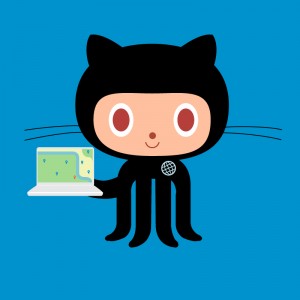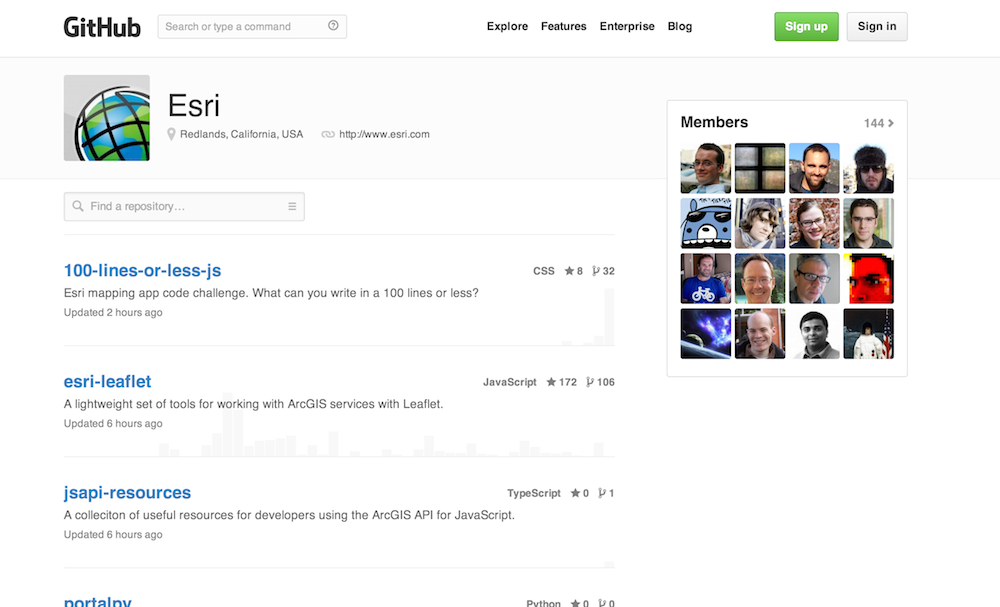 Esri has several initiatives developing an open platform. A year ago, I blogged about our foray into consolidating our code and the GIS community to GitHub as our forum for sharing, and indeed actively working, on open-source code. At the time we had about 50 projects and a few dozen engineers. A modest though nascent beginning for a large enterprise and community of users that number in the millions.
Esri has several initiatives developing an open platform. A year ago, I blogged about our foray into consolidating our code and the GIS community to GitHub as our forum for sharing, and indeed actively working, on open-source code. At the time we had about 50 projects and a few dozen engineers. A modest though nascent beginning for a large enterprise and community of users that number in the millions.
Since then, we have organically grown the understanding and utilization of open-source both internal to Esri as well as heavily promoted to our developer community. The value is clear: through active and public collaboration we can effectively deliver a platform that empowers anyone with the freedom and ownership to customize solutions to their own domain. Our community spans the entire domain of government, science, education, commercial, and industrial practice. As a company it would be impossible for us to effectively serve every users need. Instead, open-source enables the community to scale itself.
State of the Source
 Today we now support more than 200 open source projects in our GitHub organization, and over 600 Esri developers that directly collaborate on these and numerous other personal open-source projects. We have released projects that cover nearly every level of the technology stack, from web frameworks to mobile apps to big data geoprocessing. Story Maps enable you to develop location narratives, local government tools for civic developers, spatial analysis dashboards, and integration with R.
Today we now support more than 200 open source projects in our GitHub organization, and over 600 Esri developers that directly collaborate on these and numerous other personal open-source projects. We have released projects that cover nearly every level of the technology stack, from web frameworks to mobile apps to big data geoprocessing. Story Maps enable you to develop location narratives, local government tools for civic developers, spatial analysis dashboards, and integration with R.
Social coding is more than hosting projects. The community has actively participated. There are more than 1,700 watchers, 1,700 forks, and most importantly, almost 900 pull-requests in our public repositories. (Interestingly, while the numbers of watcher and forks are nearly the same, they vary widely across projects, indicating preferences by domain or language to monitor versus participate).
That doesn’t even account for the magnitude of projects each of these 600+ engineers maintain on their own – so explore a few of the engineers.
Changing How We Work
This transition is much more than skin deep – it is fundamentally changing how we build our software. Esri now uses GitHub Enterprise to host all of our code internally. Social coding happens across the company, where anyone can submit a pull-request (and subsequent automated testing, comments, and rebasing) to nearly any other part of our platform. We realize that good ideas come from many places–sometimes from deep in engineering and other times from sitting next to the customers and users seeing how they work. We need to reduce the friction for collaboration while maintaining transparency and stability.

Next week at our annual DevSummit, GitHub CEO and Co-Founder Chris Wanstrath is keynoting, sharing his experience to the entire community as well as working with us to learn how we are growing a 40-year-old successful enterprise with new tools and methodologies.
Many Sides of Open

An Open platform has many aspects and we have a number of open initiatives. Our open-source work enables developers access and freedom to re-use code to create technical solutions. We continue to be supporters of open standards that enable interoperability between solutions. Open Data is the fuel that powers any solution and across our community we are making it easier to quickly and effectively share authoritative and high-quality data to the world. And for the domain experts, students, and everyone, our Creative Commons licensed open content means learning and sharing the knowledge to actually make sense of it all.
It’s been a year and it has been tremendous the growth we’ve seen. However, for anyone that has a basic understanding of physics it’s the initial acceleration that’s the most difficult. I’m excited what will happen over the next year now that we’re really getting up to speed!
insider